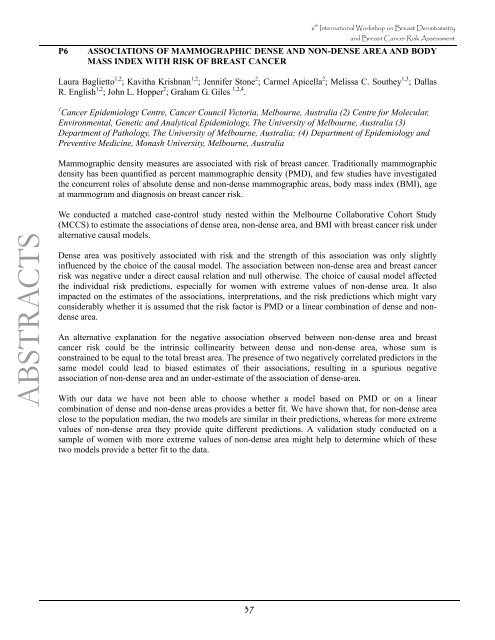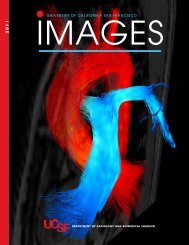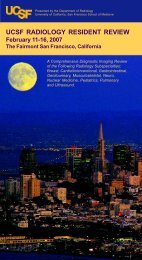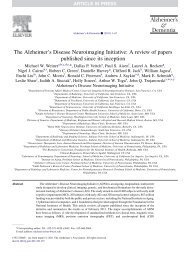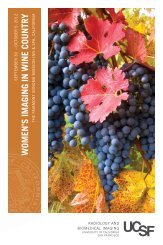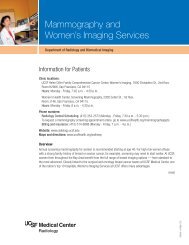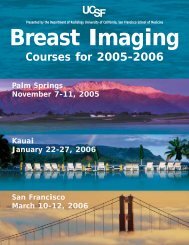6th International Workshop on Breast Densitometry and Breast ...
6th International Workshop on Breast Densitometry and Breast ...
6th International Workshop on Breast Densitometry and Breast ...
- No tags were found...
You also want an ePaper? Increase the reach of your titles
YUMPU automatically turns print PDFs into web optimized ePapers that Google loves.
P6<br />
6 th <str<strong>on</strong>g>Internati<strong>on</strong>al</str<strong>on</strong>g> <str<strong>on</strong>g>Workshop</str<strong>on</strong>g> <strong>on</strong> <strong>Breast</strong> <strong>Densitometry</strong><br />
<strong>and</strong> <strong>Breast</strong> Cancer Risk Assessment<br />
ASSOCIATIONS OF MAMMOGRAPHIC DENSE AND NON-DENSE AREA AND BODY<br />
MASS INDEX WITH RISK OF BREAST CANCER<br />
Laura Baglietto 1,2 ; Kavitha Krishnan 1,2 ; Jennifer St<strong>on</strong>e 2 ; Carmel Apicella 2 ; Melissa C. Southey 1,3 ; Dallas<br />
R. English 1,2 ; John L. Hopper 2 ; Graham G. Giles 1,2,4 .<br />
1 Cancer Epidemiology Centre, Cancer Council Victoria, Melbourne, Australia (2) Centre for Molecular,<br />
Envir<strong>on</strong>mental, Genetic <strong>and</strong> Analytical Epidemiology, The University of Melbourne, Australia (3)<br />
Department of Pathology, The University of Melbourne, Australia; (4) Department of Epidemiology <strong>and</strong><br />
Preventive Medicine, M<strong>on</strong>ash University, Melbourne, Australia<br />
Mammographic density measures are associated with risk of breast cancer. Traditi<strong>on</strong>ally mammographic<br />
density has been quantified as percent mammographic density (PMD), <strong>and</strong> few studies have investigated<br />
the c<strong>on</strong>current roles of absolute dense <strong>and</strong> n<strong>on</strong>-dense mammographic areas, body mass index (BMI), age<br />
at mammogram <strong>and</strong> diagnosis <strong>on</strong> breast cancer risk.<br />
ABSTRACTS<br />
We c<strong>on</strong>ducted a matched case-c<strong>on</strong>trol study nested within the Melbourne Collaborative Cohort Study<br />
(MCCS) to estimate the associati<strong>on</strong>s of dense area, n<strong>on</strong>-dense area, <strong>and</strong> BMI with breast cancer risk under<br />
alternative causal models.<br />
Dense area was positively associated with risk <strong>and</strong> the strength of this associati<strong>on</strong> was <strong>on</strong>ly slightly<br />
influenced by the choice of the causal model. The associati<strong>on</strong> between n<strong>on</strong>-dense area <strong>and</strong> breast cancer<br />
risk was negative under a direct causal relati<strong>on</strong> <strong>and</strong> null otherwise. The choice of causal model affected<br />
the individual risk predicti<strong>on</strong>s, especially for women with extreme values of n<strong>on</strong>-dense area. It also<br />
impacted <strong>on</strong> the estimates of the associati<strong>on</strong>s, interpretati<strong>on</strong>s, <strong>and</strong> the risk predicti<strong>on</strong>s which might vary<br />
c<strong>on</strong>siderably whether it is assumed that the risk factor is PMD or a linear combinati<strong>on</strong> of dense <strong>and</strong> n<strong>on</strong>dense<br />
area.<br />
An alternative explanati<strong>on</strong> for the negative associati<strong>on</strong> observed between n<strong>on</strong>-dense area <strong>and</strong> breast<br />
cancer risk could be the intrinsic collinearity between dense <strong>and</strong> n<strong>on</strong>-dense area, whose sum is<br />
c<strong>on</strong>strained to be equal to the total breast area. The presence of two negatively correlated predictors in the<br />
same model could lead to biased estimates of their associati<strong>on</strong>s, resulting in a spurious negative<br />
associati<strong>on</strong> of n<strong>on</strong>-dense area <strong>and</strong> an under-estimate of the associati<strong>on</strong> of dense-area.<br />
With our data we have not been able to choose whether a model based <strong>on</strong> PMD or <strong>on</strong> a linear<br />
combinati<strong>on</strong> of dense <strong>and</strong> n<strong>on</strong>-dense areas provides a better fit. We have shown that, for n<strong>on</strong>-dense area<br />
close to the populati<strong>on</strong> median, the two models are similar in their predicti<strong>on</strong>s, whereas for more extreme<br />
values of n<strong>on</strong>-dense area they provide quite different predicti<strong>on</strong>s. A validati<strong>on</strong> study c<strong>on</strong>ducted <strong>on</strong> a<br />
sample of women with more extreme values of n<strong>on</strong>-dense area might help to determine which of these<br />
two models provide a better fit to the data.<br />
37


